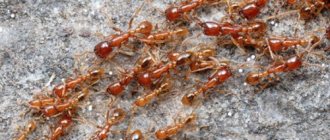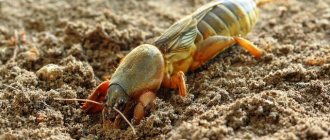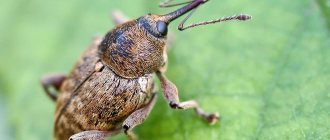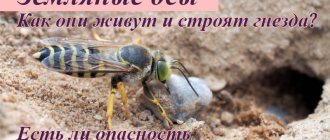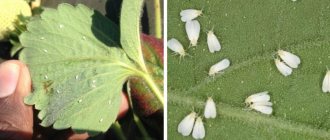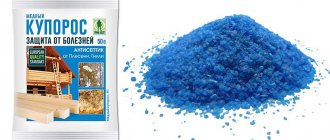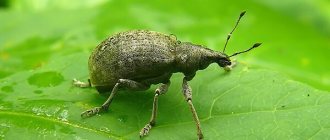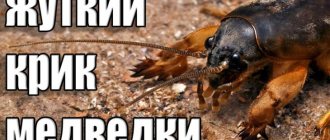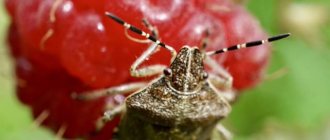Among the many ways to protect your garden from pests, fighting mole crickets with ammonia is the most accessible and safe. Mole crickets, like many harmful insects, try to avoid sources of strong odors. Ammonia is ammonium hydroxide or ammonia, which, in addition to its repellent odor, also has the beneficial properties of a nitrogen fertilizer.
Important!
Ammonia is characterized by a very pungent odor and can have a negative impact on a person’s well-being. Therefore, when working with ammonia preparation, it is recommended to wear a respirator.
Before using ammonia, you need to carefully read the instructions and follow the exact proportions when preparing the solution. Ammonia is based on alcohol, which evaporates very quickly. Therefore, all procedures should be done quickly, immediately after preparing the necessary liquid.
Recipes for fighting mole crickets
There are several ways to use ammonia from mole crickets in the garden or at the dacha:
- ammonia solution with water for watering seedlings;
- wetting scraps of fabric with ammonia to repel insects;
- use of ammonia water during planting.
The most important period for rooting a plant is the first 30 days from the day it is planted in the ground. It is at this moment that the root system of vegetable crops is especially vulnerable. Therefore, protection from mole crickets is necessary in the first month of planting.
"Pedigree" of the pest
The insect belongs to the order Orthoptera. Its closest relatives are grasshoppers, crickets and locusts. The pest has a gnawing type mouthparts and wings, with the help of which it can fly long distances in search of a new habitat.
The mole cricket is capable of flying at a height of up to 5 m. During the mating season, females fly into the air in search of a male, who sits in his burrow and calls them with melodic “cricket” trills. But the mole cricket cannot jump like its other relative, the grasshopper, since its hind legs are not designed for jumping. But the front legs are a masterpiece of evolution; they are fully adapted for digging.
The mole cricket is a southern insect, but in recent years, due to climate change, it has appeared in the middle zone. The insect does not tolerate harsh winters and drought, so many gardeners in Siberia, Kazakhstan, and the northern and northeastern parts of Russia have not even heard of such a pest.
Ammonia water for treating holes
When planting a plant in a garden bed, you need to take care of its protection from the first days. To do this, pour a solution of ammonia into the dug hole. The recipe requires 3 tablespoons of ammonia mixed with 10 liters of water. This amount is enough to process several beds. Spend approximately 300–500 ml of liquid per well.
After the procedure, you need to immediately plant the seedlings. Ammonia from cabbage will protect the plant for about 7 days. After this, it is necessary to apply additional pest protection products.
Plant repellent plants
The easiest way to keep mole crickets away from your area. There are plants whose smell repels pests. These are marigolds, calendula, chrysanthemum - they can be planted near garden plantings, taking into account the characteristics of a successful neighborhood. Medium-thick alder or aspen branches with bark, stuck into the ground to a depth of about 30 cm, will also save the situation.
The insect does not like the smell of fresh pine needles. You can also take advantage of this and place branches of spruce, fir, and pine trees between the rows of plantings.
According to one version, the mole cricket received its Russian-language name because it spends the winter in deep holes, like a bear in a den.
Using ammonia solution for regular watering
To combat mole crickets throughout the entire rooting period of plants after planting, you need to use ammonia water for irrigation. To do this, add 10 ml of alcohol to a bucket of water. Then water the solution at the root of each crop, avoiding getting it on the leaves. Pour no more than half a liter of solution onto one bush.
On a note!
Ammonia protects against mole crickets only for the first 6-7 days after treatment. Ammonia quickly evaporates and the procedure must be repeated every week.
In the case of carrot and beet beds, where seedlings are planted very often, it is recommended to water with ammonia water between the rows of plants. Consumption of the product is no more than one liter per 1 meter of bed.
Preparing the product yourself
Everyone asks the question - how to effectively poison mole crickets without negative consequences for themselves and their garden crops. Mole cricket poison is sold ready-made, or you can prepare it yourself.
The simplest, most accessible and no less effective version of a toxic substance is boric acid. A tasteless and odorless substance can be bought at a pharmacy in the form of a solution or in a specialized store as a powder. Boric acid penetrates the integument of insects, but has a greater effect when it enters the stomach.
Before you get rid of mole crickets in your garden using traps, you should make sure that you are ready to further destroy pests with your own hands, the size of which may impress an untrained amateur vegetable grower. If the readiness to fight is only theoretical, you should think about delegating these powers to professionals. Are you confident in your abilities? Then it's time to go on the warpath with the harmful insect.
- Medvedka got its name for a reason. She really never misses a chance to enjoy honey, jam or sugar syrup. And this weakness of theirs can be used as a means in the struggle for the harvest. It is enough to dig glass jars, the neck of which will be smeared with sticky and sweet bait, in the area of the paths extended into the garden (possibly in the boundaries). The bottom of the container should be generously moistened with beer, which also emits an aroma that is attractive to the pest. At night, the invaders attracted by the delicacy will fall into the traps set. And then they will need to be disposed of somehow.
- Containers dug level to the ground and filled to the brim with a mixture of water and vegetable oil are another effective trap. The film formed on the surface prevents the penetration of air and prevents objects caught in the liquid from floating up.
- Preparing for winter can be a good time to deal with underground inhabitants. For wintering, they choose warm places underground. Accordingly, the trap should be prepared according to the following principle: dug holes up to half a meter deep should be covered with plastic wrap, covered with manure and humus, covered with a layer of soil and left until frost, provided with marks. Insects that have entered the winter area will have to be removed and destroyed in the future.
- The melting of snow in the area is the time for a new stage of the offensive operation. Cover the soil surface with covering material, roofing felt or other covering. After this, all that remains is to wait until the pests come to the surface to bask in the rays of the sun, and organize their collection and subsequent disposal.
- When scattering manure on the site, do not forget that it is the main delicacy and habitat for “earthen crayfish”. In May, this feature can be used to your advantage. It is enough to wait until clutches of eggs or already hatched larvae appear in the dung piles left in the garden. Then they are simply collected and burned.
- Knowing the location of the underground guest's passages, you can drive him out of the ground using ordinary water mixed with a soap solution (about 1 liter of a mixture in a 10:1 ratio) or vegetable oil. The prepared liquid is poured into the holes. After this, all that remains is to wait until the insect begins to flee from an unplanned flood.
All these products have one common advantage - they are completely safe for the biosphere of the garden and its beneficial inhabitants. Natural ingredients do not harm plants. But all of them are effective only if the pest invasion has begun recently and their population has not yet reached critical levels. In all other cases, you should rely not on folk wisdom, but on time-tested chemicals.
Using ammonia to repel
If you find cabbage weeds in your garden, you should arm yourself with all means against them. To do this, you can use pieces of cloth soaked in ammonia. The dose of ammonia must be significant for a long-lasting effect. Ammonia can be used in its pure form for these purposes.
Place the prepared rags in the holes of cabbage plants or lay them out along the beds throughout the garden. To preserve the scent for a long time, it is recommended to place the fabric in a sealed bag and make several holes in it. After 7-8 days, wet the cloths again.
The use of ammonia in the fight against mole crickets
Use eggshells
This will require a little more effort, but not much either. In order to use eggshells, you need to start collecting them in the fall. The shells are crushed, dried a little and placed in a bucket. In the spring it is placed in holes with garden crops. The mole cricket scratches its limbs on the shell, and when it eats it, it dies. Additionally, shells are sprinkled over the entire soil in the garden, which also helps fight slugs.
The method is also good because eggshells simultaneously fertilize the garden, saturating the soil with calcium, phosphorus, potassium, silicon, magnesium and other useful substances.
- How to properly use eggshells - all about the benefits for the garden
Winter is ahead, which means it's time to start sorting waste and collecting eggshells for the garden. You'll have a great supply by spring!
Precautionary measures
If used correctly, ammonia will be an excellent assistant in the fight against mole crickets. When using the product, it is important to take precautions so as not to harm your health. Basic rules for using ammonia:
- You cannot prepare the solution for people with hypertension - inhaling the vapors can cause an increase in blood pressure;
- Do not combine alcohol with substances containing chlorine (for example, bleaches);
- You can interact with ammonia only in rooms with good ventilation or in the open air;
- contact of ammonia solution on the skin, eyes, mucous membranes of the mouth or nose will cause a severe burning sensation; such consequences can be prevented when using the drug to combat mole crickets with the help of personal protective equipment (gauze mask, rubber gloves);
- Alcohol should be stored out of the reach of animals and children, since sudden inhalation of it can cause a reflex cessation of breathing, and if ingested, it will cause a serious burn to the esophagus and oral cavity.
Reviews
Last year I planted tomato seedlings in the garden. And after a couple of weeks it was all destroyed. Pulling it out of the ground, I discovered damaged roots. Neighbors in the area suggested that this was the work of cabbage grass, and ammonia would help get rid of it. I took their advice, watered the new seedlings with the solution, and all the bushes survived.
I always water tomatoes and peppers with ammonia against mole crickets in the garden. During the month, while the plants take root, you need to water them weekly with an ammonia solution of 10 ml per 10 liters of water. You just need to monitor the condition of the seedling leaves. If they begin to turn yellow, stop watering, otherwise the plant will be ruined by an excess of nitrogen fertilizer.
I have always been lucky with seedlings; most of them took root well. But this summer a real attack happened. More than half of the tomatoes and peppers died. I read articles on the Internet about similar situations and reviews of them. I came to the conclusion that it was the cabbage grass that destroyed my plantings. To get rid of the mole cricket and preserve the remaining bushes, I watered them with ammonia dissolved in a bucket of water. Additionally, I laid out scraps of fabric soaked in ammonia around the beds and along the perimeter of the area. All my tricks helped. The remaining vegetables survived.
The mole cricket is a well-known garden pest that causes significant damage to agriculture. People call it “kapusyanka”. But this does not mean that it only damages cabbage. Many vegetable and garden crops are attacked by this insect. That is why the fight against mole crickets is an important issue that worries almost every land owner.
LiveInternetLiveInternet
—Quote book
Online - excursions to the Hermitage Repositories and Laboratories Carriages in the Hermitage Repository Nev.
Dmitry Samin “100 great artists” Rublev, Veronese, Goya, van Gogh, Durer, Kandinsky, Mati.
Are different rulers really hiding under the name of Ivan the Terrible: Four “faces” of the first Russian.
Hermitage / amazing site. repost PLEASANT WALK.
“The Abduction of Proserpina by Pluto” by Gian Lorenzo Bernini “I conquered marble and.
—Applications
- always no analogues at hand
^_^ Allows you to insert a panel with an arbitrary Html code into your profile. You can place banners, counters, etc. there - Postcards
Reborn catalog of postcards for all occasions - Cheap flights
Favorable prices, easy search, no commission, 24 hours. Book now - pay later! - I am a photographer
Plugin for publishing photos in the user's diary. Minimum system requirements: Internet Explorer 6, Fire Fox 1.5, Opera 9.5, Safari 3.1.1 with JavaScript enabled. Maybe it will work - Online game "Big Farm"
Uncle George left you his farm, but, unfortunately, it is not in very good condition. But thanks to your business acumen and the help of neighbors, friends and family, you are able to turn around a failing business.
—Categories
- cooking (761)
- poultry dishes / chicken, turkey / (68)
- blanks (53)
- desserts, snacks (49)
- sauces (31)
- made from meat (24)
- bread (24)
- multicooker (23)
- jam (14)
- dish decorations (11)
- sausage/ham (8)
- pasties (7)
- low calorie recipes (6)
- tips (3)
- vegetable dishes (37)
- baked goods, sweets (333)
- pies not sweet (59)
- salads (41)
- soups (6)
- knitting (695)
- different knitting techniques (42)
- socks (23)
- knitted dresses (17)
- mittens (14)
- Irish lace (14)
- from leftovers (10)
- enterlac (8)
- knitted patchwork (7)
- knitting and fabric, combined knitting (6)
- Nicky Epstein (6)
- knitting for men (3)
- knitting magazines (3)
- knitting from designers (1)
- crochet (205)
- knitting (344)
- scarves, hats (39)
- all sorts of ideas (99)
- New Year (14)
- cinema (78)
- Psychology (67)
- humor (50)
- Icons, prayers (37)
- diary (29)
- decoupage (26)
- potholders, seats (26)
- rugs (18)
- ribbon embroidery (15)
- tablecloths, napkins (13)
- cars, equipment (9)
- unusual fabrics (8)
- crazywool (3)
- interior (7)
- atelier (7)
- houses (4)
- aquarium (3)
- stencils (2)
- weaving (1)
- antique (1)
- weaving (0)
- Broomstick, Peruvian knitting (4)
- vintage, shabi chic (37)
- burlap (16)
- virtual tours (6)
- embroidery (75)
- dacha (66)
- my flowers (16)
- decoupage cards, vintage prints (15)
- diet/healthy food (118)
- painting (113)
- Russian Museum (8)
- textile toys (309)
- knitted toys (83)
- from newspapers (28)
- foreign languages (35)
- English (17)
- French (5)
- German (5)
- Italian (4)
- Spanish (4)
- History (43)
- interesting people (18)
- yoga (87)
- meditation (22)
- coffee toys (21)
- beauty and health (303)
- for hair (47)
- health, recipes, tips (18)
- massage (14)
- baths, wraps (11)
- face cream (42)
- lotions (20)
- face masks (133)
- scrub (29)
- modeling, cold porcelain (53)
- missoni (14)
- Moscow (25)
- museums (12)
- Music (75)
- patchwork, quilt, crazy (51)
- blankets (41)
- pillows (61)
- just curious (43)
- Romanovs (9)
- online performances, audiobooks (103)
- performances online (20)
- poetry (28)
- bags (93)
- chain stitch (5)
- slippers (17)
- fitness (57)
- photo (34)
- fabric flowers (63)
- tea, coffee (26)
- sewing (50)
